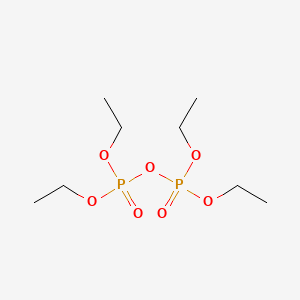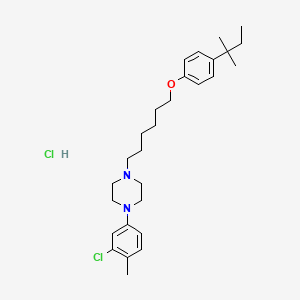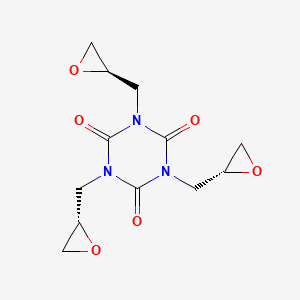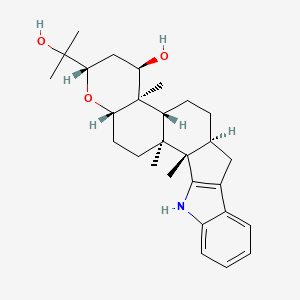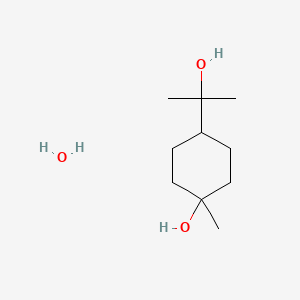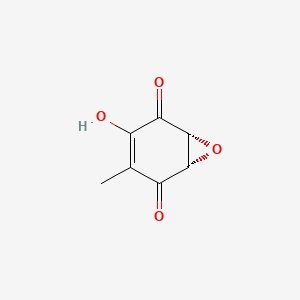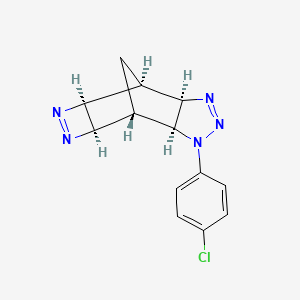
Tolbutamide
Vue d'ensemble
Description
Le tolbutamide est un médicament hypoglycémiant oral de la première génération des sulfonylurées, principalement utilisé dans la prise en charge du diabète de type 2. Il a été découvert en 1956 et agit en stimulant la sécrétion d'insuline par le pancréas, ce qui permet de réduire la glycémie . Malgré son efficacité, le this compound n'est plus utilisé de manière routinière aujourd'hui en raison de la disponibilité de nouvelles sulfonylurées de deuxième génération présentant moins d'effets secondaires .
Mécanisme D'action
Target of Action
Tolbutamide is an oral antihyperglycemic agent used for the treatment of non-insulin-dependent diabetes mellitus (NIDDM). It belongs to the sulfonylurea class of insulin secretagogues, which act by stimulating β cells of the pancreas to release insulin .
Mode of Action
This compound works by stimulating the secretion of endogenous insulin from pancreatic β-cells . It increases both basal insulin secretion and meal-stimulated insulin release . Sulfonylureas also increase peripheral glucose utilization, decrease hepatic gluconeogenesis, and may increase the number and sensitivity of insulin receptors .
Biochemical Pathways
This compound is primarily metabolized by CYP2C9 to hydroxymethylthis compound . This metabolic pathway is the primary site of genetic control . The rate of metabolism to 4’-hydroxy-tolbutamide versus CYP2C9 genotypes has been examined in healthy volunteers .
Pharmacokinetics
This compound is rapidly absorbed and distributed with a volume of distribution (Vd) of 0.15 L/kg . It is metabolized in the liver via CYP2C9 to mildly active hydroxymethylthis compound and inactive carboxythis compound . This compound and its metabolites are excreted in urine (75-85%) and feces . The onset of action is 1 hour, time to peak serum concentration is 3-4 hours, and the duration of action is 6-24 hours . The elimination half-life is 4.5-6.5 hours .
Result of Action
The result of this compound’s action is the lowering of blood glucose concentration. This is achieved by stimulating the secretion of insulin from pancreatic β-cells, enhancing peripheral sensitivity to insulin, and reducing basal hepatic glucose production .
Action Environment
Both genetic and environmental factors influence this compound metabolism . A single gene affecting P-450 mediated oxidation
Applications De Recherche Scientifique
Tolbutamide has a wide range of scientific research applications:
Chemistry: It is used in studies involving molecular recognition and host-guest chemistry.
Medicine: this compound is primarily used to manage type 2 diabetes mellitus by stimulating insulin secretion.
Industry: It is used in the formulation of sustained drug delivery systems, such as liposomal drug delivery.
Analyse Biochimique
Biochemical Properties
Tolbutamide interacts with the sulfonylurea receptor (SUR1) on the pancreatic β cells. This interaction stimulates the release of insulin, increasing both basal insulin secretion and meal-stimulated insulin release . It also increases peripheral glucose utilization, decreases hepatic gluconeogenesis, and may increase the number and sensitivity of insulin receptors .
Cellular Effects
This compound influences cell function by stimulating the acute release of insulin from functioning beta cells of pancreatic islet tissue . This leads to an increase in peripheral glucose utilization and a decrease in hepatic gluconeogenesis .
Molecular Mechanism
This compound exerts its effects at the molecular level by binding to the sulfonylurea receptor on the beta cell, stimulating the acute release of insulin . This process involves the inhibition of ATP-sensitive potassium channels on the beta cell membrane, leading to depolarization and calcium influx, which triggers insulin release .
Temporal Effects in Laboratory Settings
The effects of this compound have been observed to change over time in laboratory settings. For instance, the binding of this compound to albumin in subdomain IIA and/or IIIA as well as in subdomains IB and IIB influences its therapeutic effect .
Metabolic Pathways
This compound is metabolized in the liver, primarily via oxidation of the p-methyl group, producing the carboxyl metabolite, 1-butyl-3-p-carboxyphenylsulfonylurea . It may also be metabolized to hydroxythis compound .
Transport and Distribution
This compound is transported from the brain to the blood via a non-P-glycoprotein efflux transport system, which is inhibited by sulphonamides . It is detectable in plasma 30-60 minutes following oral administration, with peak plasma concentrations occurring within 3-5 hours .
Méthodes De Préparation
Voies de synthèse et conditions de réaction : Le tolbutamide peut être synthétisé par réaction du p-toluène sulfonamide avec de l'isocyanate de butyle en présence de triéthylamine et de tétrahydrofurane . Une autre méthode consiste à dissoudre un dérivé de carbamate spécifique dans du toluène chaud, à ajouter lentement de la butylamine et à refluxer pendant quatre heures .
Méthodes de production industrielle : En milieu industriel, les particules de this compound peuvent être préparées en mélangeant le médicament en vrac avec un fluide supercritique pour former un mélange supercritique, qui est ensuite détendu pour obtenir les particules de this compound . Cette méthode est particulièrement utile pour la production de micro-particules de this compound.
Analyse Des Réactions Chimiques
Types de réactions : Le tolbutamide subit diverses réactions chimiques, notamment des réactions d'oxydation, de réduction et de substitution.
Réactifs et conditions courants :
Oxydation : Le this compound peut être oxydé à l'aide d'agents oxydants forts.
Réduction : Les réactions de réduction impliquent généralement l'utilisation d'agents réducteurs comme l'hydrure de lithium aluminium.
Substitution : Les réactions de substitution peuvent se produire en présence de nucléophiles ou d'électrophiles dans des conditions appropriées.
Principaux produits : Les principaux produits formés à partir de ces réactions dépendent des réactifs et des conditions spécifiques utilisés. Par exemple, l'oxydation peut donner des dérivés d'acide sulfonique, tandis que la réduction pourrait produire des dérivés d'amine.
4. Applications de la Recherche Scientifique
Le this compound a un large éventail d'applications dans la recherche scientifique :
Chimie : Il est utilisé dans des études impliquant la reconnaissance moléculaire et la chimie hôte-invité.
5. Mécanisme d'Action
Le this compound exerce ses effets hypoglycémiants en stimulant la libération d'insuline par les cellules bêta pancréatiques. Il y parvient en se liant aux canaux potassiques sensibles à l'ATP des cellules bêta et en les inhibant, ce qui provoque une dépolarisation cellulaire et une libération d'insuline subséquente . De plus, le this compound réduit la production de glucose par le foie et augmente la sensibilité à l'insuline au niveau des sites cibles périphériques .
Comparaison Avec Des Composés Similaires
Le tolbutamide appartient à la classe des sulfonylurées des sécrétagogues d'insuline, qui comprend d'autres composés tels que l'acétohexamide, la chlorpropamide et la tolazamide . Comparé à ces composés, le this compound a une durée d'action plus courte et une incidence plus élevée d'effets secondaires . Il reste un outil précieux dans la gestion du diabète en raison de son apparition rapide d'action et de son efficacité à stimuler la libération d'insuline.
Composés Similaires :
- Acétohexamide
- Chlorpropamide
- Tolazamide
Le caractère unique du this compound réside dans son métabolisme rapide et sa courte durée d'action, ce qui le rend adapté à une utilisation chez les personnes âgées .
Propriétés
IUPAC Name |
1-butyl-3-(4-methylphenyl)sulfonylurea | |
|---|---|---|
| Source | PubChem | |
| URL | https://pubchem.ncbi.nlm.nih.gov | |
| Description | Data deposited in or computed by PubChem | |
InChI |
InChI=1S/C12H18N2O3S/c1-3-4-9-13-12(15)14-18(16,17)11-7-5-10(2)6-8-11/h5-8H,3-4,9H2,1-2H3,(H2,13,14,15) | |
| Source | PubChem | |
| URL | https://pubchem.ncbi.nlm.nih.gov | |
| Description | Data deposited in or computed by PubChem | |
InChI Key |
JLRGJRBPOGGCBT-UHFFFAOYSA-N | |
| Source | PubChem | |
| URL | https://pubchem.ncbi.nlm.nih.gov | |
| Description | Data deposited in or computed by PubChem | |
Canonical SMILES |
CCCCNC(=O)NS(=O)(=O)C1=CC=C(C=C1)C | |
| Source | PubChem | |
| URL | https://pubchem.ncbi.nlm.nih.gov | |
| Description | Data deposited in or computed by PubChem | |
Molecular Formula |
C12H18N2O3S | |
| Record name | TOLBUTAMIDE | |
| Source | CAMEO Chemicals | |
| URL | https://cameochemicals.noaa.gov/chemical/21120 | |
| Description | CAMEO Chemicals is a chemical database designed for people who are involved in hazardous material incident response and planning. CAMEO Chemicals contains a library with thousands of datasheets containing response-related information and recommendations for hazardous materials that are commonly transported, used, or stored in the United States. CAMEO Chemicals was developed by the National Oceanic and Atmospheric Administration's Office of Response and Restoration in partnership with the Environmental Protection Agency's Office of Emergency Management. | |
| Explanation | CAMEO Chemicals and all other CAMEO products are available at no charge to those organizations and individuals (recipients) responsible for the safe handling of chemicals. However, some of the chemical data itself is subject to the copyright restrictions of the companies or organizations that provided the data. | |
| Source | PubChem | |
| URL | https://pubchem.ncbi.nlm.nih.gov | |
| Description | Data deposited in or computed by PubChem | |
DSSTOX Substance ID |
DTXSID8021359 | |
| Record name | Tolbutamide | |
| Source | EPA DSSTox | |
| URL | https://comptox.epa.gov/dashboard/DTXSID8021359 | |
| Description | DSSTox provides a high quality public chemistry resource for supporting improved predictive toxicology. | |
Molecular Weight |
270.35 g/mol | |
| Source | PubChem | |
| URL | https://pubchem.ncbi.nlm.nih.gov | |
| Description | Data deposited in or computed by PubChem | |
Physical Description |
Tolbutamide appears as white crystals. (NTP, 1992), Solid | |
| Record name | TOLBUTAMIDE | |
| Source | CAMEO Chemicals | |
| URL | https://cameochemicals.noaa.gov/chemical/21120 | |
| Description | CAMEO Chemicals is a chemical database designed for people who are involved in hazardous material incident response and planning. CAMEO Chemicals contains a library with thousands of datasheets containing response-related information and recommendations for hazardous materials that are commonly transported, used, or stored in the United States. CAMEO Chemicals was developed by the National Oceanic and Atmospheric Administration's Office of Response and Restoration in partnership with the Environmental Protection Agency's Office of Emergency Management. | |
| Explanation | CAMEO Chemicals and all other CAMEO products are available at no charge to those organizations and individuals (recipients) responsible for the safe handling of chemicals. However, some of the chemical data itself is subject to the copyright restrictions of the companies or organizations that provided the data. | |
| Record name | Tolbutamide | |
| Source | Human Metabolome Database (HMDB) | |
| URL | http://www.hmdb.ca/metabolites/HMDB0015256 | |
| Description | The Human Metabolome Database (HMDB) is a freely available electronic database containing detailed information about small molecule metabolites found in the human body. | |
| Explanation | HMDB is offered to the public as a freely available resource. Use and re-distribution of the data, in whole or in part, for commercial purposes requires explicit permission of the authors and explicit acknowledgment of the source material (HMDB) and the original publication (see the HMDB citing page). We ask that users who download significant portions of the database cite the HMDB paper in any resulting publications. | |
Solubility |
>40.6 [ug/mL] (The mean of the results at pH 7.4), less than 1 mg/mL at 61 °F (NTP, 1992), SOL IN ALC & CHLOROFORM; FREELY SOL IN WATER; VERY SLIGHTLY SOL IN ETHER /SODIUM SALT/, DISSOLVES READILY IN AQ NAOH TO FORM SODIUM DERIV, SOL IN ETHANOL, CHLOROFORM; FREELY IN DIMETHYL CARBONATE; INSOL IN WATER, Sol in ethanol, ethyl ether, and chloroform., In water, 109 mg/l @ 37 °C, 2.02e-01 g/L | |
| Record name | SID855782 | |
| Source | Burnham Center for Chemical Genomics | |
| URL | https://pubchem.ncbi.nlm.nih.gov/bioassay/1996#section=Data-Table | |
| Description | Aqueous solubility in buffer at pH 7.4 | |
| Record name | TOLBUTAMIDE | |
| Source | CAMEO Chemicals | |
| URL | https://cameochemicals.noaa.gov/chemical/21120 | |
| Description | CAMEO Chemicals is a chemical database designed for people who are involved in hazardous material incident response and planning. CAMEO Chemicals contains a library with thousands of datasheets containing response-related information and recommendations for hazardous materials that are commonly transported, used, or stored in the United States. CAMEO Chemicals was developed by the National Oceanic and Atmospheric Administration's Office of Response and Restoration in partnership with the Environmental Protection Agency's Office of Emergency Management. | |
| Explanation | CAMEO Chemicals and all other CAMEO products are available at no charge to those organizations and individuals (recipients) responsible for the safe handling of chemicals. However, some of the chemical data itself is subject to the copyright restrictions of the companies or organizations that provided the data. | |
| Record name | Tolbutamide | |
| Source | DrugBank | |
| URL | https://www.drugbank.ca/drugs/DB01124 | |
| Description | The DrugBank database is a unique bioinformatics and cheminformatics resource that combines detailed drug (i.e. chemical, pharmacological and pharmaceutical) data with comprehensive drug target (i.e. sequence, structure, and pathway) information. | |
| Explanation | Creative Common's Attribution-NonCommercial 4.0 International License (http://creativecommons.org/licenses/by-nc/4.0/legalcode) | |
| Record name | TOLBUTAMIDE | |
| Source | Hazardous Substances Data Bank (HSDB) | |
| URL | https://pubchem.ncbi.nlm.nih.gov/source/hsdb/3393 | |
| Description | The Hazardous Substances Data Bank (HSDB) is a toxicology database that focuses on the toxicology of potentially hazardous chemicals. It provides information on human exposure, industrial hygiene, emergency handling procedures, environmental fate, regulatory requirements, nanomaterials, and related areas. The information in HSDB has been assessed by a Scientific Review Panel. | |
| Record name | Tolbutamide | |
| Source | Human Metabolome Database (HMDB) | |
| URL | http://www.hmdb.ca/metabolites/HMDB0015256 | |
| Description | The Human Metabolome Database (HMDB) is a freely available electronic database containing detailed information about small molecule metabolites found in the human body. | |
| Explanation | HMDB is offered to the public as a freely available resource. Use and re-distribution of the data, in whole or in part, for commercial purposes requires explicit permission of the authors and explicit acknowledgment of the source material (HMDB) and the original publication (see the HMDB citing page). We ask that users who download significant portions of the database cite the HMDB paper in any resulting publications. | |
Density |
1.245 at 77 °F (NTP, 1992) - Denser than water; will sink, 1.245 g/cu cm @ 25 °C | |
| Record name | TOLBUTAMIDE | |
| Source | CAMEO Chemicals | |
| URL | https://cameochemicals.noaa.gov/chemical/21120 | |
| Description | CAMEO Chemicals is a chemical database designed for people who are involved in hazardous material incident response and planning. CAMEO Chemicals contains a library with thousands of datasheets containing response-related information and recommendations for hazardous materials that are commonly transported, used, or stored in the United States. CAMEO Chemicals was developed by the National Oceanic and Atmospheric Administration's Office of Response and Restoration in partnership with the Environmental Protection Agency's Office of Emergency Management. | |
| Explanation | CAMEO Chemicals and all other CAMEO products are available at no charge to those organizations and individuals (recipients) responsible for the safe handling of chemicals. However, some of the chemical data itself is subject to the copyright restrictions of the companies or organizations that provided the data. | |
| Record name | TOLBUTAMIDE | |
| Source | Hazardous Substances Data Bank (HSDB) | |
| URL | https://pubchem.ncbi.nlm.nih.gov/source/hsdb/3393 | |
| Description | The Hazardous Substances Data Bank (HSDB) is a toxicology database that focuses on the toxicology of potentially hazardous chemicals. It provides information on human exposure, industrial hygiene, emergency handling procedures, environmental fate, regulatory requirements, nanomaterials, and related areas. The information in HSDB has been assessed by a Scientific Review Panel. | |
Mechanism of Action |
Sulfonylureas lower blood glucose in patients with NIDDM by directly stimulating the acute release of insulin from functioning beta cells of pancreatic islet tissue by an unknown process that involves a sulfonylurea receptor (receptor 1) on the beta cell. Sulfonylureas inhibit the ATP-potassium channels on the beta cell membrane and potassium efflux, which results in depolarization and calcium influx, calcium-calmodulin binding, kinase activation, and release of insulin-containing granules by exocytosis, an effect similar to that of glucose., SULFONYLUREAS STIMULATE ISLET TISSUE TO SECRETE INSULIN. ... SULFONYLUREAS CAUSE DEGRANULATION OF BETA CELLS, A PHENOMENON ASSOC WITH INCR RATE OF SECRETION OF INSULIN. /SULFONYLUREAS/, ALTHOUGH MOLECULAR MECHANISM...NOT UNDERSTOOD, SEVERAL PERTINENT OBSERVATIONS HAVE BEEN MADE. ...TOLBUTAMIDE IS RESTRICTED IN ITS ACTION TO EXTRACELLULAR SPACE & DOES NOT NEED TO ENTER BETA CELL. INVOKED RELEASE OF INSULIN IS IMMEDIATE & INTIMATELY RELATED TO ACTION OF GLUCOSE...MAY SENSITIZE CELL TO NORMAL SECRETAGOGUE., Sulfonylureas are now...thought to act by a number of different mechanisms. 1. ...produce a depolarization of the pancreatic islet beta cell membrane potassium ion permeability. This results in a release of preformed insulin into the circulation and occurs mostly in non-insulin dependent diabetics. 2. ...reduce basal glucose output from the liver... 3. increase insulin receptor binding... 4. ...increasing intracellular levels of AMP... 5. increase insulin secretion by suppressing the release of glucagon and somatostatin from alpha and delta pancreatic cells. /Sulfonylureas/ | |
| Record name | Tolbutamide | |
| Source | DrugBank | |
| URL | https://www.drugbank.ca/drugs/DB01124 | |
| Description | The DrugBank database is a unique bioinformatics and cheminformatics resource that combines detailed drug (i.e. chemical, pharmacological and pharmaceutical) data with comprehensive drug target (i.e. sequence, structure, and pathway) information. | |
| Explanation | Creative Common's Attribution-NonCommercial 4.0 International License (http://creativecommons.org/licenses/by-nc/4.0/legalcode) | |
| Record name | TOLBUTAMIDE | |
| Source | Hazardous Substances Data Bank (HSDB) | |
| URL | https://pubchem.ncbi.nlm.nih.gov/source/hsdb/3393 | |
| Description | The Hazardous Substances Data Bank (HSDB) is a toxicology database that focuses on the toxicology of potentially hazardous chemicals. It provides information on human exposure, industrial hygiene, emergency handling procedures, environmental fate, regulatory requirements, nanomaterials, and related areas. The information in HSDB has been assessed by a Scientific Review Panel. | |
Color/Form |
WHITE OR PRACTICALLY WHITE CRYSTALLINE POWDER, Crystals | |
CAS No. |
64-77-7 | |
| Record name | TOLBUTAMIDE | |
| Source | CAMEO Chemicals | |
| URL | https://cameochemicals.noaa.gov/chemical/21120 | |
| Description | CAMEO Chemicals is a chemical database designed for people who are involved in hazardous material incident response and planning. CAMEO Chemicals contains a library with thousands of datasheets containing response-related information and recommendations for hazardous materials that are commonly transported, used, or stored in the United States. CAMEO Chemicals was developed by the National Oceanic and Atmospheric Administration's Office of Response and Restoration in partnership with the Environmental Protection Agency's Office of Emergency Management. | |
| Explanation | CAMEO Chemicals and all other CAMEO products are available at no charge to those organizations and individuals (recipients) responsible for the safe handling of chemicals. However, some of the chemical data itself is subject to the copyright restrictions of the companies or organizations that provided the data. | |
| Record name | Tolbutamide | |
| Source | CAS Common Chemistry | |
| URL | https://commonchemistry.cas.org/detail?cas_rn=64-77-7 | |
| Description | CAS Common Chemistry is an open community resource for accessing chemical information. Nearly 500,000 chemical substances from CAS REGISTRY cover areas of community interest, including common and frequently regulated chemicals, and those relevant to high school and undergraduate chemistry classes. This chemical information, curated by our expert scientists, is provided in alignment with our mission as a division of the American Chemical Society. | |
| Explanation | The data from CAS Common Chemistry is provided under a CC-BY-NC 4.0 license, unless otherwise stated. | |
| Record name | Tolbutamide [USP:INN:BAN:JAN] | |
| Source | ChemIDplus | |
| URL | https://pubchem.ncbi.nlm.nih.gov/substance/?source=chemidplus&sourceid=0000064777 | |
| Description | ChemIDplus is a free, web search system that provides access to the structure and nomenclature authority files used for the identification of chemical substances cited in National Library of Medicine (NLM) databases, including the TOXNET system. | |
| Record name | Tolbutamide | |
| Source | DrugBank | |
| URL | https://www.drugbank.ca/drugs/DB01124 | |
| Description | The DrugBank database is a unique bioinformatics and cheminformatics resource that combines detailed drug (i.e. chemical, pharmacological and pharmaceutical) data with comprehensive drug target (i.e. sequence, structure, and pathway) information. | |
| Explanation | Creative Common's Attribution-NonCommercial 4.0 International License (http://creativecommons.org/licenses/by-nc/4.0/legalcode) | |
| Record name | tolbutamide | |
| Source | DTP/NCI | |
| URL | https://dtp.cancer.gov/dtpstandard/servlet/dwindex?searchtype=NSC&outputformat=html&searchlist=757354 | |
| Description | The NCI Development Therapeutics Program (DTP) provides services and resources to the academic and private-sector research communities worldwide to facilitate the discovery and development of new cancer therapeutic agents. | |
| Explanation | Unless otherwise indicated, all text within NCI products is free of copyright and may be reused without our permission. Credit the National Cancer Institute as the source. | |
| Record name | tolbutamide | |
| Source | DTP/NCI | |
| URL | https://dtp.cancer.gov/dtpstandard/servlet/dwindex?searchtype=NSC&outputformat=html&searchlist=23813 | |
| Description | The NCI Development Therapeutics Program (DTP) provides services and resources to the academic and private-sector research communities worldwide to facilitate the discovery and development of new cancer therapeutic agents. | |
| Explanation | Unless otherwise indicated, all text within NCI products is free of copyright and may be reused without our permission. Credit the National Cancer Institute as the source. | |
| Record name | Benzenesulfonamide, N-[(butylamino)carbonyl]-4-methyl- | |
| Source | EPA Chemicals under the TSCA | |
| URL | https://www.epa.gov/chemicals-under-tsca | |
| Description | EPA Chemicals under the Toxic Substances Control Act (TSCA) collection contains information on chemicals and their regulations under TSCA, including non-confidential content from the TSCA Chemical Substance Inventory and Chemical Data Reporting. | |
| Record name | Tolbutamide | |
| Source | EPA DSSTox | |
| URL | https://comptox.epa.gov/dashboard/DTXSID8021359 | |
| Description | DSSTox provides a high quality public chemistry resource for supporting improved predictive toxicology. | |
| Record name | Tolbutamide | |
| Source | European Chemicals Agency (ECHA) | |
| URL | https://echa.europa.eu/substance-information/-/substanceinfo/100.000.541 | |
| Description | The European Chemicals Agency (ECHA) is an agency of the European Union which is the driving force among regulatory authorities in implementing the EU's groundbreaking chemicals legislation for the benefit of human health and the environment as well as for innovation and competitiveness. | |
| Explanation | Use of the information, documents and data from the ECHA website is subject to the terms and conditions of this Legal Notice, and subject to other binding limitations provided for under applicable law, the information, documents and data made available on the ECHA website may be reproduced, distributed and/or used, totally or in part, for non-commercial purposes provided that ECHA is acknowledged as the source: "Source: European Chemicals Agency, http://echa.europa.eu/". Such acknowledgement must be included in each copy of the material. ECHA permits and encourages organisations and individuals to create links to the ECHA website under the following cumulative conditions: Links can only be made to webpages that provide a link to the Legal Notice page. | |
| Record name | TOLBUTAMIDE | |
| Source | FDA Global Substance Registration System (GSRS) | |
| URL | https://gsrs.ncats.nih.gov/ginas/app/beta/substances/982XCM1FOI | |
| Description | The FDA Global Substance Registration System (GSRS) enables the efficient and accurate exchange of information on what substances are in regulated products. Instead of relying on names, which vary across regulatory domains, countries, and regions, the GSRS knowledge base makes it possible for substances to be defined by standardized, scientific descriptions. | |
| Explanation | Unless otherwise noted, the contents of the FDA website (www.fda.gov), both text and graphics, are not copyrighted. They are in the public domain and may be republished, reprinted and otherwise used freely by anyone without the need to obtain permission from FDA. Credit to the U.S. Food and Drug Administration as the source is appreciated but not required. | |
| Record name | TOLBUTAMIDE | |
| Source | Hazardous Substances Data Bank (HSDB) | |
| URL | https://pubchem.ncbi.nlm.nih.gov/source/hsdb/3393 | |
| Description | The Hazardous Substances Data Bank (HSDB) is a toxicology database that focuses on the toxicology of potentially hazardous chemicals. It provides information on human exposure, industrial hygiene, emergency handling procedures, environmental fate, regulatory requirements, nanomaterials, and related areas. The information in HSDB has been assessed by a Scientific Review Panel. | |
| Record name | Tolbutamide | |
| Source | Human Metabolome Database (HMDB) | |
| URL | http://www.hmdb.ca/metabolites/HMDB0015256 | |
| Description | The Human Metabolome Database (HMDB) is a freely available electronic database containing detailed information about small molecule metabolites found in the human body. | |
| Explanation | HMDB is offered to the public as a freely available resource. Use and re-distribution of the data, in whole or in part, for commercial purposes requires explicit permission of the authors and explicit acknowledgment of the source material (HMDB) and the original publication (see the HMDB citing page). We ask that users who download significant portions of the database cite the HMDB paper in any resulting publications. | |
Melting Point |
262 to 264 °F (NTP, 1992), 128.5-129.5 °C, MP: 41-43 °C; when anhyd, mp range is 130-133 °C /Sodium salt tetrahydrate/, 128.5 °C | |
| Record name | TOLBUTAMIDE | |
| Source | CAMEO Chemicals | |
| URL | https://cameochemicals.noaa.gov/chemical/21120 | |
| Description | CAMEO Chemicals is a chemical database designed for people who are involved in hazardous material incident response and planning. CAMEO Chemicals contains a library with thousands of datasheets containing response-related information and recommendations for hazardous materials that are commonly transported, used, or stored in the United States. CAMEO Chemicals was developed by the National Oceanic and Atmospheric Administration's Office of Response and Restoration in partnership with the Environmental Protection Agency's Office of Emergency Management. | |
| Explanation | CAMEO Chemicals and all other CAMEO products are available at no charge to those organizations and individuals (recipients) responsible for the safe handling of chemicals. However, some of the chemical data itself is subject to the copyright restrictions of the companies or organizations that provided the data. | |
| Record name | Tolbutamide | |
| Source | DrugBank | |
| URL | https://www.drugbank.ca/drugs/DB01124 | |
| Description | The DrugBank database is a unique bioinformatics and cheminformatics resource that combines detailed drug (i.e. chemical, pharmacological and pharmaceutical) data with comprehensive drug target (i.e. sequence, structure, and pathway) information. | |
| Explanation | Creative Common's Attribution-NonCommercial 4.0 International License (http://creativecommons.org/licenses/by-nc/4.0/legalcode) | |
| Record name | TOLBUTAMIDE | |
| Source | Hazardous Substances Data Bank (HSDB) | |
| URL | https://pubchem.ncbi.nlm.nih.gov/source/hsdb/3393 | |
| Description | The Hazardous Substances Data Bank (HSDB) is a toxicology database that focuses on the toxicology of potentially hazardous chemicals. It provides information on human exposure, industrial hygiene, emergency handling procedures, environmental fate, regulatory requirements, nanomaterials, and related areas. The information in HSDB has been assessed by a Scientific Review Panel. | |
| Record name | Tolbutamide | |
| Source | Human Metabolome Database (HMDB) | |
| URL | http://www.hmdb.ca/metabolites/HMDB0015256 | |
| Description | The Human Metabolome Database (HMDB) is a freely available electronic database containing detailed information about small molecule metabolites found in the human body. | |
| Explanation | HMDB is offered to the public as a freely available resource. Use and re-distribution of the data, in whole or in part, for commercial purposes requires explicit permission of the authors and explicit acknowledgment of the source material (HMDB) and the original publication (see the HMDB citing page). We ask that users who download significant portions of the database cite the HMDB paper in any resulting publications. | |
Retrosynthesis Analysis
AI-Powered Synthesis Planning: Our tool employs the Template_relevance Pistachio, Template_relevance Bkms_metabolic, Template_relevance Pistachio_ringbreaker, Template_relevance Reaxys, Template_relevance Reaxys_biocatalysis model, leveraging a vast database of chemical reactions to predict feasible synthetic routes.
One-Step Synthesis Focus: Specifically designed for one-step synthesis, it provides concise and direct routes for your target compounds, streamlining the synthesis process.
Accurate Predictions: Utilizing the extensive PISTACHIO, BKMS_METABOLIC, PISTACHIO_RINGBREAKER, REAXYS, REAXYS_BIOCATALYSIS database, our tool offers high-accuracy predictions, reflecting the latest in chemical research and data.
Strategy Settings
| Precursor scoring | Relevance Heuristic |
|---|---|
| Min. plausibility | 0.01 |
| Model | Template_relevance |
| Template Set | Pistachio/Bkms_metabolic/Pistachio_ringbreaker/Reaxys/Reaxys_biocatalysis |
| Top-N result to add to graph | 6 |
Feasible Synthetic Routes
Q1: How does tolbutamide exert its hypoglycemic effect?
A1: this compound primarily acts by binding to and blocking the ATP-sensitive potassium channels (KATP channels) on the surface of pancreatic beta cells. [, ] This action leads to membrane depolarization, opening of voltage-gated calcium channels, and influx of calcium ions. The increased intracellular calcium levels trigger the release of preformed insulin from the beta cells. [, ]
Q2: Does this compound have any effects on insulin secretion beyond KATP channel blockade?
A2: While KATP channel blockade is the primary mechanism, research suggests that this compound might also enhance the effects of glucose on insulin secretion, potentially through mechanisms involving intracellular signaling pathways. [] Further research is needed to fully elucidate these additional effects.
Q3: Can this compound stimulate insulin release in the absence of glucose?
A3: Studies on isolated rat pancreatic islets have shown that this compound alone does not induce significant insulin release. [] Its insulin-releasing action is potentiated in the presence of glucose, even when glucose metabolism is impaired. [] This suggests a synergistic effect between glucose and this compound on insulin secretion.
Q4: What is the molecular formula and weight of this compound?
A4: The molecular formula of this compound is C12H18N2O3S, and its molecular weight is 270.35 g/mol.
Q5: Are there any known stability issues with this compound formulations?
A6: this compound can undergo hydrolysis in acidic conditions, leading to the formation of p-toluenesulfonamide. [] This degradation pathway necessitates careful consideration during formulation development to ensure drug stability.
Q6: How is this compound metabolized in the body?
A7: this compound is primarily metabolized in the liver by the cytochrome P450 enzyme CYP2C9. [] The primary metabolic pathway involves oxidation to hydroxythis compound, which is inactive. [] Genetic variations in CYP2C9 can significantly influence this compound metabolism and elimination rates. []
Q7: Are there any known drug interactions that affect this compound metabolism?
A8: Several drugs can interact with this compound metabolism, primarily by inhibiting CYP2C9 activity. [, , ] Examples include:
- Sulfaphenazole: This antimicrobial drug is a potent inhibitor of this compound metabolism, significantly increasing its half-life. [, ]
- Phenylbutazone and oxyphenbutazone: These anti-inflammatory drugs can also inhibit this compound metabolism, although their effect might be delayed and potentially linked to enzyme induction. []
- Antimalarial drugs: Compounds like mefloquine, sulfadoxine-pyrimethamine, and quinine have shown inhibitory effects on this compound metabolism in vitro. []
Q8: Does this compound affect the pharmacokinetics of other drugs?
A9: Research suggests that this compound itself does not significantly affect the metabolism of drugs primarily metabolized by CYP2C9. [] This finding implies a low risk of this compound causing clinically relevant drug interactions through CYP2C9 inhibition.
Q9: What is the impact of age on this compound pharmacokinetics and pharmacodynamics?
A10: Studies have shown that while the blood concentration of this compound remains relatively unaffected by age, its hypoglycemic effect might be reduced in elderly patients. [] This suggests a potential age-related decline in the sensitivity of pancreatic beta cells to this compound.
Q10: What preclinical models have been used to study the effects of this compound?
A10: Various in vitro and in vivo models have been employed, including:
- Isolated rat pancreatic islets: This model is useful for investigating the direct effects of this compound on insulin secretion from beta cells. [, ]
- Perfused rat liver: This model allows for the study of this compound's impact on hepatic glucose metabolism and ketogenesis. []
- Precision-cut liver slices from rats and dogs: This model helps in understanding species and sex differences in this compound metabolism. []
- Alloxan-induced diabetic rats: This in vivo model mimics type 1 diabetes and helps evaluate the hypoglycemic effect of this compound in a diabetic state. []
- Triphenyltin chloride-induced diabetic rabbits: This model is used to study the effects of this compound on insulin secretion and glucose metabolism when the KATP channel signaling pathway is disrupted. []
Q11: Has this compound shown efficacy in treating congenital hyperinsulinism (CHI)?
A12: While this compound has been used to assess beta-cell function in CHI patients, it is not considered a primary treatment option. [] Studies have shown that acute insulin responses to this compound stimulation are modest in focal CHI patients, potentially indicating beta-cell quiescence in the healthy pancreatic tissue. []
Q12: Are there any concerns regarding the safety of this compound?
A12: While generally considered safe for most patients, this compound has been associated with potential side effects, including:
- Hypoglycemia: This is the most common side effect, particularly in patients with impaired renal or hepatic function. []
- Gastrointestinal disturbances: Nausea, vomiting, and heartburn have been reported. []
- Hematologic abnormalities: Rare cases of agranulocytosis, bone marrow aplasia, and red cell aplasia have been observed. []
Avertissement et informations sur les produits de recherche in vitro
Veuillez noter que tous les articles et informations sur les produits présentés sur BenchChem sont destinés uniquement à des fins informatives. Les produits disponibles à l'achat sur BenchChem sont spécifiquement conçus pour des études in vitro, qui sont réalisées en dehors des organismes vivants. Les études in vitro, dérivées du terme latin "in verre", impliquent des expériences réalisées dans des environnements de laboratoire contrôlés à l'aide de cellules ou de tissus. Il est important de noter que ces produits ne sont pas classés comme médicaments et n'ont pas reçu l'approbation de la FDA pour la prévention, le traitement ou la guérison de toute condition médicale, affection ou maladie. Nous devons souligner que toute forme d'introduction corporelle de ces produits chez les humains ou les animaux est strictement interdite par la loi. Il est essentiel de respecter ces directives pour assurer la conformité aux normes légales et éthiques en matière de recherche et d'expérimentation.




